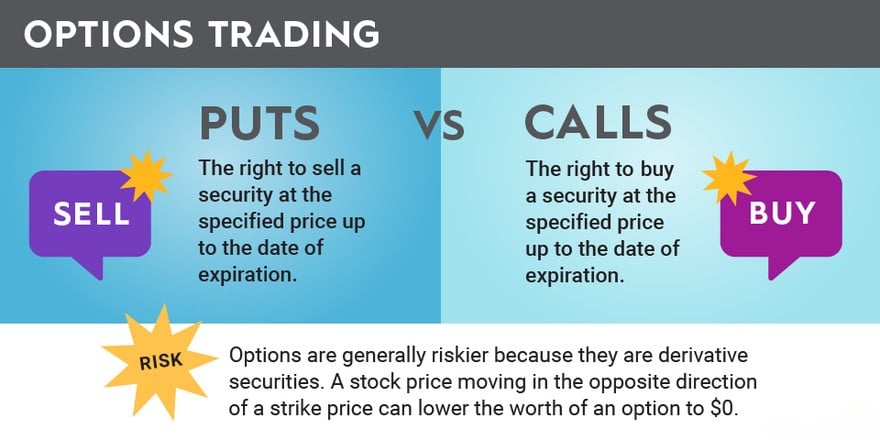How Options Trading Works
How Options Trading Works
A Comprehensive Guide for 2025

Introduction
Options trading has gained massive popularity as traders seek strategies beyond traditional stock investments. Whether you’re a beginner or an advanced trader, understanding how options trading works can help you manage risk, maximize profits, and diversify your portfolio. In this guide, we’ll break down how options trading works, covering essential concepts, strategies, and real-world applications.
What Are Options in Trading?
Options are financial derivatives that give traders the right, but not the obligation, to buy or sell an asset at a specific price before a set expiration date. They are typically used for speculation, hedging, or income generation.
Types of Options Contracts
- Call Options: Give the buyer the right to purchase an asset at a predetermined price.
- Put Options: Give the buyer the right to sell an asset at a predetermined price.
Key Terms You Must Know
- Strike Price: The price at which the option can be exercised.
- Premium: The cost of buying the option.
- Expiration Date: The date by which the option must be exercised.
- Intrinsic Value: The difference between the asset’s price and the strike price (if profitable).
- Extrinsic Value: The portion of the option’s price that comes from time remaining and volatility.
- Time Decay: The reduction in an option’s value as expiration nears.
How Options Trading Works
Buying and Selling Options
Traders can buy or sell call and put options depending on their market outlook:
- Buying Calls: Traders expect the price of the underlying asset to rise.
- Buying Puts: Traders expect the price to fall.
- Selling Calls (Writing Calls): Traders believe the price will stay the same or drop.
- Selling Puts (Writing Puts): Traders believe the price will stay the same or increase.
Options Pricing: The Greeks
Options prices are influenced by several factors, collectively called the Greeks:
- Delta: Measures the sensitivity of the option’s price to the underlying asset’s price movement.
- Theta: Represents time decay.
- Vega: Measures how sensitive an option is to volatility.
- Gamma: Tracks how delta changes as the asset price moves.
Why Trade Options? Benefits & Risks
Benefits of Options Trading
- Leverage: Control a larger position with a smaller investment.
- Flexibility: Trade various market conditions with multiple strategies.
- Hedging: Reduce risk by protecting your portfolio from downturns.
- Income Generation: Sell options and collect premiums.
Risks of Options Trading
- High Volatility: Options can lose value quickly.
- Expiration Risks: Options become worthless if not exercised.
- Complex Strategies: Advanced strategies require expertise.
- Time Decay: Options lose value as they near expiration.
Basic Options Trading Strategies for Beginners
1. Covered Call (Best for Generating Income)
A trader who owns a stock sells a call option against it, collecting a premium while agreeing to sell the stock if the price rises above the strike price.
2. Protective Put (Best for Hedging)
Buying a put option as insurance against a stock you own in case the price drops.
3. Long Straddle (Best for Volatility Trading)
Buying both a call and a put at the same strike price, allowing profits from significant price movements in either direction.
4. Iron Condor (Best for Low-Volatility Markets)
A combination of selling a lower-strike put, buying a higher-strike put, selling a higher-strike call, and buying a lower-strike call to profit from minimal price movement.
Advanced Options Trading Strategies
1. Credit Spreads (Bull Put & Bear Call Spreads)
A strategy that profits from time decay by selling a higher-premium option and buying a lower-premium option.
2. Butterfly Spread (Low-Risk Strategy)
Combines buying and selling options at three different strike prices to limit risk and maximize potential gains.
3. Calendar Spread (Time Decay Strategy)
Involves buying a long-term option and selling a short-term option at the same strike price to profit from time decay.
How to Get Started with Options Trading
Step 1: Choose a Reliable Brokerage
Look for a brokerage that offers:
- Low commission fees.
- Fast execution speeds.
- User-friendly platforms.
- Advanced tools for analysis.
Step 2: Learn Options Trading Fundamentals
Master concepts like implied volatility, time decay, the Greeks, and trading strategies.
Step 3: Paper Trade Before Using Real Money
Most platforms offer simulated trading accounts where you can practice without financial risk.
Step 4: Develop a Risk Management Plan
- Use stop losses to limit downside risk.
- Avoid overleveraging your account.
- Diversify your strategies.
Step 5: Stay Updated on Market Trends
Follow financial news, earnings reports, and market analysis to make informed trades.
Common Mistakes to Avoid in Options Trading
- Ignoring Time Decay: New traders often underestimate the impact of time decay.
- Overtrading: Trading too frequently increases commissions and risks.
- Using Options Without a Clear Plan: Always have an entry and exit strategy.
- Not Understanding the Greeks: The Greeks significantly impact options pricing and risk.
- Neglecting Market Conditions: Different strategies work in different market environments.
FAQs About Options Trading
1. Is options trading better than stocks?
It depends on your goals. Options trading offers higher leverage and flexibility but comes with higher risks.
2. Can I lose more money than I invest in options?
Yes, especially if you’re selling options. However, risk can be managed with strategies like spreads.
3. How do I start trading options with a small account?
Use low-cost strategies like vertical spreads and stick to liquid options contracts.
4. How do I know which options to trade?
Analyze implied volatility, liquidity, and overall market conditions.
5. What’s the best options trading strategy for beginners?
Covered calls and cash-secured puts are the safest ways to start.
Final Thoughts
Options trading provides a powerful way to trade the market with flexibility, risk management, and profit potential. By understanding the basics, mastering key strategies, and applying risk management principles, you can navigate the options market effectively.
If you’re serious about learning how options trading works, start by paper trading, stay informed, and develop a strategy that aligns with your goals.
Check out articles on:
- Introducing to Options Trading
- Mastering Butterfly Spreads
- The Power of Diagonal Spreads
- The Power of Iron Condors
- The Power of Vertical Credit Spreads
- How to Succeed Trading Stocks, and Stock Options in a Volatile Market
Elevate Your Options Trading Skills
Ready to master options? Join our community for in-depth education on options trading, live sessions, and expert analysis of options trading strategies. Sign up today to start profiting from market swings using advanced options trading strategies!
Below are the links:
- Day Trading Room
- Swing Trading Room(Short-term)
- Small Account Mentorship
- SPX Trading Alerts(Alerts Only)
- Revolution Swings(Alerts Only)
To your success,

Billy Ribeiro is a globally recognized trader renowned for his mastery of price action analysis and innovative trading strategies. He was personally mentored by Mark McGoldrick, famously known as “Goldfinger,” Goldman Sach’s most successful investor in history. McGoldrick described Billy Ribeiro as “The Future of Trading,” a testament to his extraordinary talent. Billy Ribeiro solidified his reputation by accurately calling the Covid crash bottom, the 2022 market top, and the reversal that followed, all with remarkable precision. His groundbreaking system, “The Move Prior to The Move,” enables him to anticipate market trends with unmatched accuracy, establishing him as a true pioneer in the trading world.
Connect with us:






